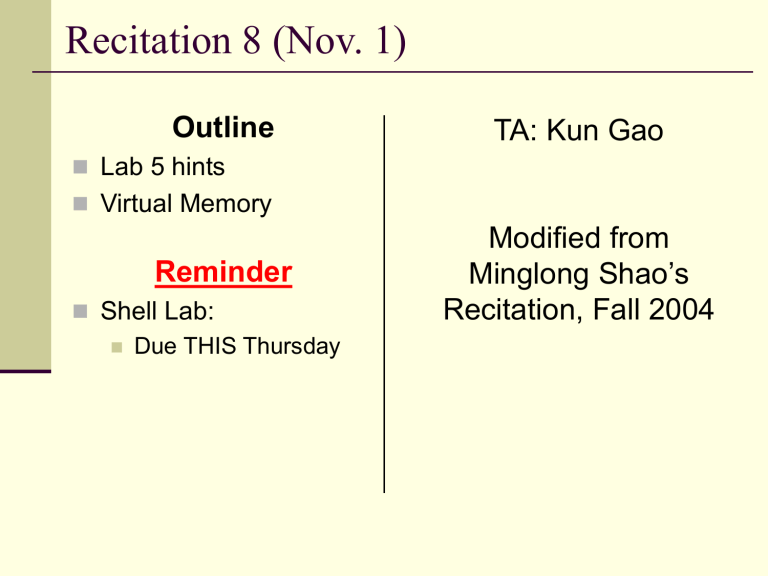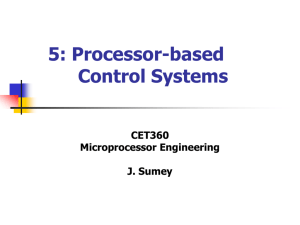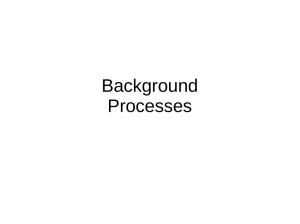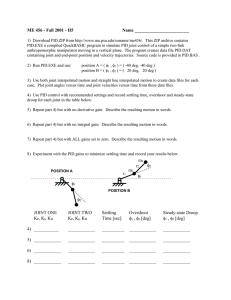Recitation 8 (Nov. 1) Outline Reminder TA: Kun Gao
advertisement

Recitation 8 (Nov. 1)
Outline
TA: Kun Gao
Lab 5 hints
Virtual Memory
Reminder
Shell Lab:
Due THIS Thursday
Modified from
Minglong Shao’s
Recitation, Fall 2004
Lab 5
A tiny shell (tsh) with job control & I/O redirection
Key points:
Understand process tree
Executing programs
Reap all child processes
Handle SIGCHLD, SIGTSTP, SIGINT
Avoid race hazard
I/O redirection
Process tree for shell
pid=10
pgid=10
Shell
Background
job #1
pid=20 Forepgid=20 ground
job
pid=32
pgid=32
Background
process group 32
Child
pid=21
pgid=20
Child
pid=22
pgid=20
Foreground
process group 20
Background
job #2
pid=40
pgid=40
Backgroud
process group 40
Each job has a unique process group id
int setpgid(pid_t pid, pid_t pgid);
setpgid(0, 0);
Process tree for shell (part 2)
pid=5
pgid=5
pid=10
pgid=10
UNIX
shell
tsh
Background
job #1
pid=20 Forepgid=20 ground
job
Foreground job
receives SIGINT, SIGTSTP,
when you type ctrl-c, ctrl-z
pid=32
pgid=32
Background
process group 32
Child
pid=21
pgid=20
Child
pid=22
pgid=20
Foreground
process group 20
Background
job #2
pid=40
pgid=40
Backgroud
process group 40
int kill(pid_t pid, int sig)
pid > 0: send sig to specified process
pid = 0: send sig to all processes in same group
pid < -1: send sig to group -pid
Execute program
int execve(const char *fname,
char *const argv[],
char *const envp[]);
Examples:
execve(“/bin/ls”, NULL, NULL);
execve(“./mytest”, argv, envp);
Reaping child process
waitpid(pid_t pid, int *status, int options)
pid: wait for child process with pid (process id or group id)
-1: wait for any child process
status: tell why child terminated
options:
WNOHANG: return immediately if no children zombied
WUNTRACED: report status of terminated or stopped children
In Lab 5, use
waitpid(-1, &status, WNOHANG|WUNTRACED)
In sigchld_handler():
while ((c_pid = waitpid(…)) > 0) { … }
Reaping child process (part 2)
int status;
waitpid(pid, &status, WNOHANG|WUNTRACED)
What to check in sigchld_handler:
WIFEXITED(status): child exited normally (the child
finished, and quit normally on its own)
WEXITSTATUS(status): returns code when child
exits
WIFSIGNALED(status): child exited because a signal is
not caught (SIGINT, or typing CTRL-C)
WTERMSIG(status): gives the terminating signal
number
WIFSTOPPED(status): child is stopped by the receipt of a
signal (SIGSTOP, or typing CTRL-Z)
WSTOPSIG(status): gives the stop signal number
Reaping child process (part 3)
Where to put waitpid(…)
In sigchld_handler(): for both
tsh should still wait for fg job to complete, how?
Busy wait for foreground job
In eval():
if(fork() != 0) { /* parent */
addjob(…);
while(fg process still alive){
/* do nothing */
}
}
Sleep
In eval():
if(fork() != 0) { /* parent */
addjob(…);
while(fg process still alive){
sleep(1);
}
}
Race hazard
A data structure is shared by two pieces of code
that can run concurrently
Different behaviors of program depending upon
how the schedule interleaves the execution of
code.
An example of race hazard
sigchld_handler() {
while ((pid = waitpid(…)) > 0){
deletejob(pid);
}
}
eval() {
pid = fork();
if(pid == 0)
{ /* child */
execve(…);
}
/* parent */
/* signal handler may run BEFORE addjob()*/
addjob(…);
}
An okay schedule
time
Shell
Signal Handler
Child
fork()
addjob()
execve()
exit()
sigchld_handler()
deletejobs()
A problematic schedule
time
Shell
Signal Handler
Child
fork()
execve()
exit()
sigchld_handler()
deletejobs()
addjob()
Job added to job list after the signal handler tried to delete it!
Solution: blocking signals
sigchld_handler() {
pid = waitpid(…);
deletejob(pid);
}
eval() {
sigprocmask(SIG_BLOCK, …)
pid = fork();
if(pid == 0)
{ /* child */
sigprocmask(SIG_UNBLOCK, …)
execve(…);
}
/* parent */
/* signal handler might run BEFORE addjob() */
addjob(…);
sigprocmask(SIG_UNBLOCK, …)
}
Solution: blocking signals (part 2)
What should our block set be?
SIGSTP
SIGINT
SIGCHLD
I/O redirection
Do it before call execve() in child process
eval() {
pid = fork();
if(pid == 0)
{ /* child */
/* Redirect I/O */
if (redirect_input)
dup2(…);/* redirect STDIN */
if (redirect_output)
dup2(…);/* redirect STDOUT */
execve(…);
}
addjob(…);
}
dup2(int oldfd, int newfd)
Covered in Chapter 11
oldfd: old file descriptor
newfd: new file descriptor
Dup2 makes newfd be a copy of the oldfd (i.e.
operations on newfd is done on oldfd instead)
Some examples:
Get input from in_fd instead of standard input
dup2(in_fd, STDIN_FILENO);
Print output to out_fd instead of standard output
dup2(out_fd, STDOUT_FILENO);
Reminders
Some important system calls:
fork(), execve(), waitpid(), sigprocmask(),
setpgid(), kill() …
Check man pages for details about system calls
man 2 kill
Check return values of all system calls
STEP by STEP
Test your shell by typing commands first
Each trace worth the same (work on easy ones
first!)
Start now!
Virtual memory
One of the most important concepts in CS
Why use virtual memory (VM)
Use RAM as a cache for disk
Easier memory management
Access protection
Enable “partial swapping”
Share memory efficiently
Virtual memory
Memory
Per Process:
0:
1:
Page Table
Virtual
Addresses
0:
1:
Physical
Addresses
CPU
P-1:
N-1:
Page
Page table
Page hits, Page faults
Demand Paging
Disk
Conceptual address translation
Higher bits of address (page number) mapped from
virtual addr. to physical addr.
Lower bits (page offset) stay the same.
p p–1
n–1
virtual page number (VPN)
page offset
0
virtual address
address translation
m–1
p p–1
physical page number (PPN)
0
page offset
Virtual Memory: up to 2n -1 bytes
Physical Memory: up to 2m -1 bytes
physical address
Address translation through page table
Translation
Separate (set of) page table(s) per process
VPN forms index into page table (points to a page table entry)
page table base register
VPN acts
as
table index
if valid=0
then page
not in memory
virtual address
n–1
p p–1
virtual page number (VPN)
page offset
0
valid access physical page number (PPN)
m–1
p p–1
physical page number (PPN)
page offset
physical address
0
Address translation with TLB
n–1
p p–1
0
virtual page number
page offset
valid
.
virtual address
tag physical page number
.
TLB
.
=
TLB hit
physical address
tag
index
valid tag
byte offset
data
Cache
=
cache hit
data
Integrating VM and cache
Most caches are physically addressed
Why?
Perform address translation before cache
lookup, could potentially go to memory =*(
TLB keeps things manageable
1. VA
CPU
4. PA
MMU/
Translation
2. VPN
3. PTE
TLB
5. Data
Cache/Memory
Integrating VM and cache (TLB hit)
Most caches are physically addressed
Why?
Perform address translation before cache
lookup, could potentially go to memory =*(
TLB keeps things manageable
1. VA
CPU
4. PA
MMU/
Translation
2. VPN
3. PTE
TLB
5. Data
Cache/Memory
Integrating VM and cache (TLB miss)
TLB miss, but page table is in cache/memory
3. PTEA (PTBP + VPN)
1. VA
CPU
MMU/
Translation
2. VPN
TLB
6. Data
5. PA
4. PTE
Cache/Memory
What is the worst case mem read
(most delay)?
TLB miss, page fault on page table, then page
fault on memory read
3. PTEA (PTBP + VPN)
1. VA
CPU
MMU/
Translation
2. VPN
5. PA
4. PTE
Cache/Memory
TLB
Page Fault/ Page Fault/
Page Table Mem Read
6. Data
DISK
Example
Understand end-to-end addr. translation
20-bit virtual addresses
18-bit physical addresses
Page size is 1024 bytes
TLB is 2-way associative with 16 total entries
Part 1
A. Virtual address
TLBT
19
18
17
16
TLBI
15
14
13
12
11
10
9
8
7
6
VPN
5
4
3
2
1
0
3
2
1
0
VPO
B. Physical address
17
16
15
14
13
PPN
12
11
10
9
8
7
6
5
4
PPO
Example: TLB and page table
Part 2
Virtual address 0x04AA4
A. 04AA4 = 0000 0100 1010 1010 0100
B. Address translation
parameter
VPN
Value
0x012
Parameter
TLB hit?
Value
Y
TLB Index
TLB Tag
0x2
0x02
Page fault?
PPN
N
0x68
C. Physical address
01 1010 0010 1010 0100
Part 2
Virtual address 0x78E6
A. 078E6 = 0000 0111 1000 1110 0110
B. Address translation
parameter
VPN
Value
0x01E
Parameter
TLB hit?
Value
N
TLB Index
TLB Tag
0x6
0x03
Page fault?
PPN
N
0x57
C. Physical address
01 0101 1100 1110 0110
End-to-end address translation
Section 10.6.4: a concrete example
Read carefully and solve practice problem 10.4






